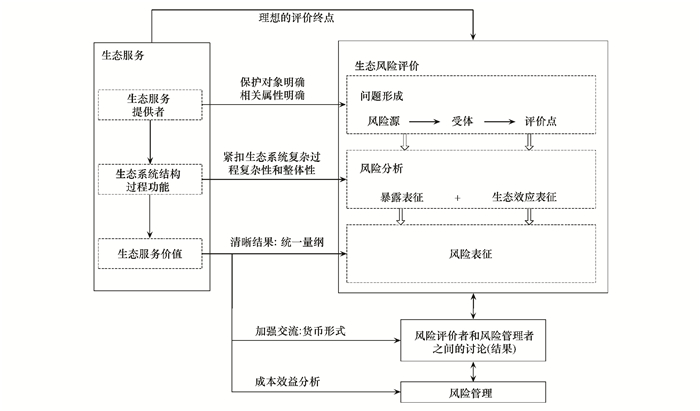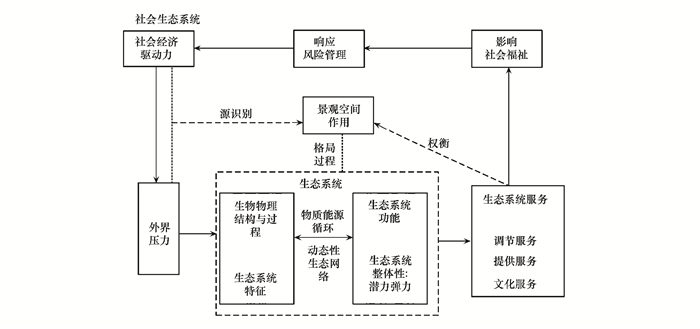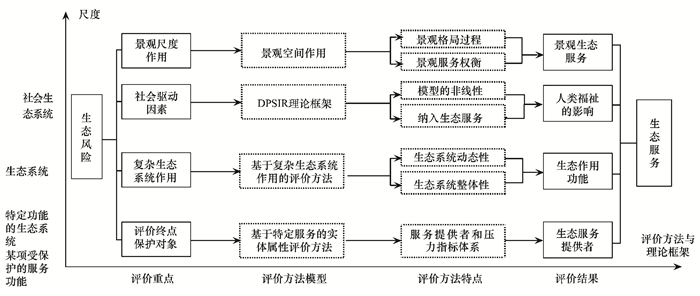文章信息
- 康鹏, 陈卫平, 王美娥
- KANG Peng, CHEN Weiping, WANG Mei'e
- 基于生态系统服务的生态风险评价研究进展
- Advancesin ecosystem service-based ecological risk assessment
- 生态学报, 2016, 36(5): 1192-1203
- Acta Ecologica Sinica, 2016, 36(5): 1192-1203
- http://dx.doi.org/10.5846/stxb201407111420
-
文章历史
- 收稿日期: 2014-07-11
- 网络出版日期: 2015-07-22
生态风险评价研究开始于20世纪70年代[1]。1992年美国环境保护署对生态风险评价作了定义,形成了生态风险评价框架,此后生态风险评价的方法和理论不断发展和完善[2, 3, 4]。由于生态系统的复杂性和不可确定性,传统生态风险评价方法在评估生态系统受一个或多个胁迫因素影响后可能产生的不利效应时,难以兼顾系统内多保护对象,也较难关注到生态系统保护对象与属性在复杂生态系统下的作用与表现[5, 6]。生态风险评价的主要目的是为生态系统保护和管理提供决策支持,仅保护生态实体而不考量与实体功能属性密切相关的人类福祉,难以落实到具体的决策层面上。因而,随着人类生活水平不断提高,生态风险评价的主题逐渐上升到与人类生活质量息息相关的生态系统服务[7, 8]。一些学者认为生态风险评价改进目的是给决策者们提供更多的信息,最终会走向生态系统过程与服务之间的关系[9, 10]。生态系统服务是联系生态系统过程与社会福祉的有效工具,近年来外界驱动因素扰动下生态系统结构和过程变化对生态系统服务的影响已成为当前区域生态系统的研究热点。一些研究尝试将生态系统服务引入到生态风险评价中,从人类福祉角度结合生态系统过程进行风险表征可极大提高评价的时效性,这也是当前生态风险评价研究的难点和前沿[11, 12]。本研究基于国内外相关文献和研究实践,首先分析了生态系统服务在生态风险评价流程中所起到的作用,然后从三个不同层面对现有的基于生态系统服务的生态风险评价应用实践进行了归纳分析,分析了评估过程中的生态风险表征方法,最后提出了相应的展望。
1 生态系统服务在生态风险评价中作用生态风险评价包括问题形成、风险分析和风险表征交流3个步骤。图 1概括了生态系统服务在生态风险评价过程中所起到的作用,包括:问题形成过程中明确保护对象与相关属性,风险分析阶段联系到生态系统结构、过程与功能,风险表征及其后续阶段可为生态系统管理提供清晰明确评估结果,加强风险评估者和决策者之间的交流和落实风险管理。

|
| 图 1 生态系统服务在生态风险评估中的作用示意图 Fig.1 The role of ecological service in progress of ecological risk assessment |
确定评价终点是问题形成阶段的主要目标,也是生态风险评价过程的基础。生态风险评价终点是指明确评价中所应受到保护的环境价值。依据USEPA给出评价终点指导目录,可理解为生物个体、种群、群落或者生态系统等层次的结构及附属功能[13, 14]。实际操作过程中,Apitiz[15]认为将评价终点联系到“生态系统结构、生态健康”等相关概念,难以把握到所需保护对象特性,需结合评价需求引入生态学概念弥补这一不足。因此,现有研究尝试将生态系统服务作为评价终点引入到评价中进行完善。
根据评价终点的概念内涵,可将其简要表达为:评价终点=属性+实体。生态系统服务作为评价终点符合该概念公式。生态系统服务可理解为在特定时空的范围内,生态系统服务提供单元实体结构和过程作用所能提供的生态功能与服务[16, 17]。因而实体可理解为该生态系统服务提供者的结构和所进行的生态过程,属性可解析为单元实体相对应功能和服务,在外界扰动下,可分析该服务提供者结构与过程的变化下功能所受到的影响[18]。
评价终点的选取准则主要包括五个方面:政策目标与社会价值、生态学关联、易感性、操作可定义性、合适的尺度[19, 20]。基于五大准则,生态系统服务中人类福祉能紧密联系到政策目标与社会价值;生态系统服务是生态系统结构、过程和功能作用下的产物,容易受到外界压力干扰而影响服务的产出,符合生态学关联和易感性等准则;在生态系统、景观等不同尺度生态系统服务已有较完善的评价指标和方法,符合操作可定义性和合适的尺度准则。以上分析表明,生态系统服务相关特点与评价终点选取准则具有很高的契合度。
基于评价终点概念公式和评价准则,图 2分析了生态系统服务作为评价终点的契合度。总的来说,将生态系统服务引入生态风险评价中既符合评价终点概念公式,又符合评价终点的选取准则,可将生态系统保护对象与属性在复杂生态系统下的作用与表现有机关联,是理想的评价终点。

|
| 图 2 生态系统服务作为生态风险评价终点的优势和契合度 Fig.2 The advantages about ecological service acted as the assessment endpoint of ecological risk |
风险分析过程中,传统的评价终点属性反应在实验操作条件下容易实现,但分析中难以将实验模拟联系到实际情况,即较少关注到生态系统整体表现以及内部关系的复杂性[21]。Power 和McCarty[22] 认为生态风险评价的改进,应从生态系统整体功能角度出发,用来研究多重压力引起系统结构过程及功能变化的作用机理。生态系统服务是物质或能量在生态系统内不同结构通过相关生态过程作用途径下产生的,可分为基本生态系统服务、中间生态系统服务和最终生态系统服务[23, 24]。将生态系统服务作为评价终点引入到生态风险评价过程中,风险分析过程能紧密联系到生态系统结构和过程,能更好关注保护对象及其属性在系统内受到干扰后的表现。因而,能在风险分析过程中关注生态系统复杂作用过程,综合考虑生态系统整体性和复杂性,这是传统的风险分析尤其是基于生物个体和种群层次的“属性”反应的分析所不能及的。
1.3 加强风险评估、管理与交流生态系统服务作为生态风险的评价终点,采用货币形式进行价值定量,使得风险表征结果清晰明确,为后续评估交流与管理奠定了良好的基础。风险交流过程中,加强交流是Chapman[25]提到的生态系统服务作为评价终点的重要优点。货币形式评估结果能引起决策者的极大兴趣,为今后风险评估者和风险管理者开展交流提供便捷的平台;当风险交流评估需考虑公众价值时,意愿调查法能将不同利益者的想法纳入风险评估的实际操作中[26, 27]。在优化风险管理方面,决策者可根据评估结果对不同风险源管理实施主次优先的风险调控,针对性地制定有效的管理措施和标准。在生态风险后续管理措施制定中,决策者能对不利生态影响或风险消减措施所带来的利益进行权衡,如利用成本效益分析生态修复或恢复所带来的生态环境服务与这些行为所产生的不良环境效应之间的利益博弈,逐步实施可行的补偿和修护计划,能有效节约时间和成本[28, 29]。
2 基于生态系统服务的生态风险评价方法当前,基于生态系统服务的生态风险评价实践还不多见,依据前面分析生态系统服务在风险评估中所起作用,结合评价方法的适应范围,可从3个不同层面上进行:一是针对某一特定功能的生态系统或系统中某项受保护的服务功能,重点关注所受保护的生态功能服务实体及属性,结合现有生态系统服务评价指标体系,提出明确的服务提供者实体与属性评价方法。二是从生态系统上,更好体现生态系统服务在风险评价中紧扣生态系统过程作用的特点,结合生态系统结构和功能体系,构建基于复杂生态系统过程的评价方法。三是在社会生态系统上,发挥生态系统服务能更好地进行生态风险管理与交流的特点,将生态系统服务纳入到生态风险管理框架或者景观风险管理中,提出社会生态系统下加强风险管理方法。
2.1 基于某种特定服务的实体属性评价方法针对某特定功能的生态系统或系统中某项受保护的服务功能,开展基于某种特定服务的实体属性风险评价,可基于如下步骤:关键生态系统服务提供者识别(生态系统服务产生的结构与功能)——识别关键驱动因子(辨别其所受到的压力源)——分别建立指标体系——运用合适的方法分析两者之间的关系——风险分析结果表征——风险管理与交流。作为代表该服务单体功能的评价指标体系,指标选取时可参考千年生态系统服务评估中的评价指标,评价某类生态系统生物多样性时可参考IEEB的生态系统服务指标体系[30, 31]。
针对农田生态系统,Faber 和Wensem[32]选取土壤肥力、生物多样性、产量供给和土壤物理结构等指标代表土地供给服务,对不同情景下农田开发利用的风险进行了评价。对重金属污染生态系统研究中,Niemeyer等人[33]重点关注生态系统调节恢复功能,选取有机物质降解和营养物质循环等指标,对生态系统服务所受到潜在的影响进行了评价。一般来说,筛选和构建能代表生态结构和过程的指标体系是基础和重要前提,随后的评价方法大都采用影响矩阵方法。Nienstedt等人[34]运用影响矩阵从生态属性、不确定性等六维尺度上尝试评价压力作用下水生生态系统中服务影响机理。Dodds等人[35]根据水生态系统服务与潜在影响之间的作用计算出权重,结合影响矩阵方法提出影响指数,用于辨识人类活动压力对水资源提供和水体净化等生态系统服务的影响。
通过上述分析,基于某种特定服务的实体属性评价方法,通过运用影响矩阵等方法能把握压力源下某项关键保护对象的属性变化,选取的生态系统服务指标能适当反映出生态系统过程,即明确了保护对象,又满足生态风险的评价需求,在一定程度上简化传统生态风险的评价流程。
2.2 基于复杂生态系统作用的评价方法生态风险在生态系统层面应用时,应强调外界压力干扰下系统结构和过程影响下物质循环速率、能量流变化对生态系统服务的影响,可结合系统整体性和动态性特点进行评价。
2.2.1 基于生态系统动态过程的评价方法生态系统作为物质与能量循环作用的复杂网络系统,物质、能量在系统内部不同结构与过程之间通过相应的生物化学过程作用下形成不同类型的生态系统服务[36]。外界压力作用下系统物质能量流动和循环速率的改变将影响到作为评价终点生态系统服务的产出。
基于生态系统动态过程的评价方法可从两个方面进行,一是针对生态系统中物质或能量循环或者是其等效实体(碳、营养物元素)开展评价。Watanabe 和Ortega[37]利用生态系统碳水平衡模型,在气候改变、土壤侵蚀等背景下,模拟了土地利用转变对与水、碳两基本元素的生物化学循环过程中有关生态系统服务的影响。Schramski等人[38]将分配控制理论运用到生态系统网络模型,以河流生态系统为例,将氮元素循环过程逐步分解并构建7个控制与分配的子系统模型,模拟了外界压力对生物固氮等生态系统服务的影响。将生态网络应用到生态风险评价中具有特定的优势,生态网络可描述复杂系统作用下不同系统和结构下能量、物质等状态变化,将成员间物质能量流输入输出标准化后可提供关于每一成员变化的定量信息,因而,能评价某特定时间尺度内系统内外界作用下系统内部成员状态及其相互间的作用关系[39]。
在生态系统整体服务功能评价方面,Chen等人[40]以信息熵为物质循环量纲,将控制理论运用到生态网络方法中,建立生态风险评价模型,将该模型运用到大坝建设对河流生态系统的风险评估,重点评价了该系统水质净化等功能之间所受到直接和间接风险。为提高该模型在风险评价中的作用,Chen等人[41]将不确定性分析理念引入到生态网络模型中,以受到风险干扰的水生态系统4个功能网络为研究对象,在建立网络指标基础上评估了水生系统内不同部分之间的生态风险。
通过上述分析来看,对受干扰的自然生态系统,基于生态系统过程和生态网络分析,能全面评价生态系统不同风险源与受体之间的直接或间接的作用关系,能较好实现对生态系统生态风险的模拟评价。
2.2.2 基于生态系统整体性的评价方法生态系统整体性包括结构整体性和功能整体性:结构整体性是指生态系统内部生物与非生物组成丰富度、格局、及其内部之间相互关联作用;功能整体性是指整体结构基础上各生物物理化学的复杂过程及所对应的功能[42]。Villamagna等人[43]建立了服务潜力、生态压力、服务需求之间相互作用的测度关系,估算了不同情景下生态系统服务可持续使用所存在的风险程度。Zell和Hubbart[44]的研究将生态系统弹力引入到生态系统评估中,选取了物质循环、生物多样性、生物化学调节等过程作用速率能够代表系统结构性和功能的效应指标,研究结果表明,系统受到外界的胁迫时,生态系统弹力能反映出关键的调节服务变化对人类福祉的影响。
生态系统整体性可认为生态系统自我管理能力和提供生态系统服务的能力[45]。作为系统结构-过程-功能的有机整体,现有研究引入生态潜力、生态系统弹力等概念来评价生态系统在外界压力影响下所表现出的性质,可以从整体上评价特定外界压力干扰对生态系统服务的影响与风险程度。
2.3 基于社会生态系统分析的评价方法社会生态系统上,为深入发挥生态系统服务在生态风险管理交流中作用,一方面尝试如运用DPSIR理论将生态系统服务纳入到生态风险管理框架中;另一方面,基于景观生态学格局过程等理论,对景观生态系统服务与风险进行研究。
2.3.1 基于DPSIR理论框架的生态风险评价与管理DPSIR用来描述环境问题以及与其相关社会经济领域的关系,其特点是构建环境、社会和经济各子系统之间的相互作用关系,评估各子系统之间的因果关系[46]。将DPSIR理论框架模型运用到生态风险管理中,分析社会经济活动驱动下生态系统过程状态改变对生态系统服务的影响,可提高模型的操作可行性。
一方面,可针对DPSIR各不同子系统中之间的简单线性关系,运用方法提升理论框架的非线性,从而达到模拟仿真现实情况的目的。Lozoya等人[47]利用DPSIR理论框架分析了海滨灾害与生态系统服务的关系,通过构建风险文件夹,明确和加强各子系统的作用途径和影响,对海滨生态系统风险评价与优化管理的发展起到了一定的推动作用。Maxim等人[48]将集对界面分析应用到DPSIR理论框架各子系统之间的供需关系,分析了外界驱动下生态系统多样性变化对生态系统服务的影响,基于该方法对欧洲两个生物多样性风险管理案例进行了理论的指导。Cook等人[49]将德尔菲法和影响矩阵运用到DPSIR理论框架中,分析了海洋生态系统下人类活动12项压力下11项生态环境状态指标的改变,及其相关11项生态系统服务的改变,该方法在风险管理中纳入了专家建议,能够对风险管理交流起到一定的推动作用。
另一方面,可将生态系统服务纳入传统DPSIR理论框架“驱动力-压力-状态-影响-驱动反馈”中,成为该框架内的一部分。Cooper[50]尝试将生态系统服务纳入到DPSIR理论框架中状态部分,即生态环境改变影响到生态系统服务的改变,并在社会福祉上进行成本效益分析,在一定程度实现了风险管理。Atkins等人[51]根据生态系统服务与社会福利的关系,将生态系统服务纳入社会生态系统影响部分中,尝试应用到英国海口水资源管理和海洋生物多样性风险管理。
2.3.2 基于景观生态系统服务的生态风险评价与管理针对大尺度的社会生态系统,传统生态风险评价需大量长期的监测数据,现有的评价方法如相对风险评价能较好解决大尺度风险评价中定量和半定量化问题,但对多风险源在空间范围风险表征形式统一及风险源与受体空间作用提出了较大的挑战[52, 53]。景观空间形态和组成在较大程度上决定生态系统服务的供给,高强度社会经济活动对景观格局和过程改变能影响到生态系统服务类型产出的变化。近年来,随着地理信息技术和景观格局过程理论的发展,景观生态系统服务评价有了长足发展,一些研究尝试将景观生态系统服务应用到社会生态系统生态风险管理中。
一方面可通过建立景观生态系统服务与压力源的空间作用关系,用于社会中人类福祉的最优化分析,提高风险管理的针对性。Allan等人[54]通过高分辨率遥感数据绘制美国五大湖生态系统服务的变化,辨别出周边压力的累积风险作用,利用空间关联性方法评价湖区生态恢复效果。Su等人[55]依据城市化过程中对生态系统服务的影响,用集变量非线性回归方法定量分析了城市化标准因子、景观格局变化指数和生态系统服务三者之间的关系,将该研究方法应用到杭嘉湖地区景观格局变化和生态系统服务价值改变的关系。针对社会生态系统相关规划,Müller[56]定义了生态系统服务潜力,依据景观结构作用的特点和社会经济活动的强度提出了压力与景观生态系统服务供给能力,运用约束模型,决策系统分析等理论方法构建景观生态系统服务与相关压力的模型,分析其在不同社会情景发展下景观生态系统服务状态变化的响应。
另一方面通过分析不同压力源对景观格局与过程的影响,即导致不同服务之间相互变化,借助成本效益理念分析同一驱动因素或压力源下各项生态系统服务的响应,为其后的生态风险管理提供理论指导和技术支撑[57, 58]。Van der Biest等人[59]建立了景观生态系统服务束(landscape ecological service bundle)的理论框架,框架充分考虑了社会生态系统内在整体性和不确定性,并运用贝叶斯网络模型分析土地利用政策驱动下不同生态系统服务博弈关系,从降低政策制定对生态系统服务风险的角度,结合不同类型用地特点制定了土地利用的优化情景。 Raudsepp-Hearne 等人[60]研究了加拿大魁北克137个自治区12种生态系统服务的空间格局和辨识出六项生态系统服务束,研究区域内社会经济活动对各项服务之间变化的关联作用,提出了降低旅游对环境影响等相关的生态保护管理措施。Wu等人[61]依据特大城市对周边生态环境的影响,以北京和周边区域为研究对象,计算和绘制物质生产、碳固定和人口支撑等五种景观生态系统服务,利用叠加和相关性分析不同服务之间的作用和识别服务热点,可根据评价结果对生态系统服务关键地区进行生态保护措施管理。
服务间博弈权衡是景观生态系统服务研究的重点,也是社会生态系统生态风险评价过程中所应关注的方面,将景观生态系统服务应用到社会生态系统生态风险管理中,对作为评价终点的生态系统服务做出全面的评估,能提高评价的真实性和可靠性,生态风险评价中做到统筹兼顾。
2.4 不同评价方法的应用特点与不足图 3解析了3个不同层次基于生态系统服务生态风险评价的逻辑作用关系。生态系统作为有机整体,外界胁迫下导致系统结构与过程中物质能量的动态变化,从而影响系统功能整体性及其生态系统服务的产生;在上述基础上解析社会经济活动驱动下对生态系统服务和社会中人类福祉的影响,可将生态系统服务纳入到DPSIR理论框架子系统中进行分析;为深入分析生态系统服务变化与风险源空间作用关系,可引入空间线性回归分析对景观生态系统服务与风险源对此进行剖析。

|
| 图 3 基于生态系统服务生态风险评价的逻辑作用关系 Fig.3 Logical effect relationships about ecological risk assessment based on ecological service |
图 4总结了三个不同层次上基于生态系统服务的风险评价方法的应用内容与特点: (1)基于某种特定服务的实体属性评价方法的适应范围是评价外界压力对某类特定功能或者系统中某些服务功能的影响,通过建立相应功能服务与对应压力的指标体系,利用影响矩阵等方法分析两者的作用关系,该评价方法直观明确,评价指标与方法一定程度上考虑到生态系统过程作用,但从复杂的生态系统作用角度考虑,需提高该方法的复杂性和非线性。(2)基于复杂生态系统作用方法,考虑生态系统整体性和动态性,引入相关概念或模型评价生态系统在外界压力作用下结构与过程变化下功能变化,能较好实现对生态风险的模拟评价;但为更好结合结构功能与生态过程,需明确与生态结构与过程相关特性表征参数。(3) 针对社会生态系统下外界驱动对社会福祉的影响,DPSIR理论框架能把握生态系统过程与社会经济之间的因果关系;但该框架内各子系统间的非线性还有待深入提高,怎样将生态系统服务纳入该框架中及其作用如何还有待于研究。景观生态系统服务能对景观上生态风险实现较好的评价与管理,现有方法仅靠线性回归等统计分析方法从定量的关系进行直观评价,应深入结合景观格局过程对其进行分析。

|
| 图 4 基于生态系统服务的风险评价方法的应用内容与特点(DPSIR: Drive-Pressure-State-Impact-Response) Fig.4 Appling content and features of ecological risk assessing methods based on ecological service |
作为生态风险表征的评价量纲,生态系统服务在表征形式与评价量纲方面具有其自身的特点。
3.1 评价表征形式一般来说,基于生态系统服务的生态风险评价中,评估结果常用生态系统服务的损失来表征。Munns等人[62]尝试将生态风险评价流程运用于传统的自然资源损害评估,评价中以生态系统服务的损失表征生态风险。目前常用生态系统服务损失的评价方法是等价分析法,是一种在服务-服务基础上确定生境损失和收益的方法,采用假定的生态标尺作为量度人类福祉变化的表征参数,衡量社会福利的环境收益和损失[63]。其关键的假设是:从服务类型、质量和价值的角度,由损害导致的服务损失应与补偿修复计划提供的服务收益相等[64]。除了生态系统服务损失的表征形式,还存在不利服务的表征形式。生态不利服务是由于生态系统在外界多重压力的胁迫累积作用下,系统结构与过程发生了质的改变下产出与人类福祉相违背的服务[65, 66]。Escobedo 等人[67]利用生态系统服务和生态不利服务综述了分析城市森林生态系统服务与外界污染作用关系。Lytimaki 和 Sipila[68]指出在生态系统管理中,应关注外界驱动因素下生态系统不利服务产生对人类福祉的影响,建议运用生态和社会学相关方法理论来解析某种不利服务相关的生态结构质变和相关的生态过程,及其对不利效应进行评估。
3.2 评价量纲评价量纲除了货币评价外,还存在“系统热力学指标”形式。生态系统服务经自然作用过程而形成,由太阳能在不同时空尺度下驱动形成,因此系统热力学指标可作为评价量纲。作为能反映出能量和物质在不同情景等级条件下转化率大小的热力学指标如能值、火用等指标均可作为评价量纲。Huang等人利用能值方法归一化城区与郊区地区所能提供的生态系统服务,通过两者之间的物质流和能流的交换使用,利用影响矩阵评价了两者之间相互作用的关系状态[69]。在不同土地利用转化对河流生态系统累积效应的研究中,Li等人利用生态系统火用等指标评价了土地利用对底栖生物的有关功能的影响[70]。Xu等人改进并提出一系列生态火用指标,通过测度不同系统的生物总量,评价白洋淀不同水域生态系统功能的健康程度[71]。系统热力学指标作为评价量纲的优点如下:一是紧密联系生态系统结构与过程,既能反映出系统内部及其与外部之间物质能量的转化传递,也能体现出生态系统状态即生态系统结构组成与功能状态;二是将生态系统物质能量流归一化后可与现实中货币量纲进行转化换算,现有一些学者根据生态系统服务和系统热力学指标在社会经济活动中评价的作用,尝试进行生态系统服务与系统热力学指标之间关系的研究,今后基于生态系统服务的生态风险评价研究可借鉴这方面的研究成果[72, 73]。
4 结论与展望本文对生态系统服务在生态风险评价中理论发展和应用实践进行了系统梳理。生态系统服务作为“理想的评价终点”,既能明确保护实体和对象,又能紧扣生态系统复杂作用过程,还能加强风险评估、交流与管理,在应用实践中可根据需求和评价对象的特点从3个层面进行生态风险评价,也可利用生态系统服务作为评价量纲提升生态风险评价时效性。
目前国内外基于生态系统服务的生态风险研究并不多见,一些方法使用大都借用生态系统服务作为评价终点的理念,大都数还都停留在探讨阶段。加强基于生态系统服务的生态风险研究,可对传统的生态风险评估框架进行完善和发展,结合现有研究特点和今后的研究需求提出以下展望:
(1)理论方面,为更好将评价终点落实保护对象实体及属性,需要参考现有的生态系统服务评价指标,构建完善的生态系统服务提供者的指标体系,在生态复杂过程实践操作中,需提升生态过程的主要参数选取及获取的能力,可借鉴现有生态系统结构、过程和功能有关模型将生态系统过程整合到生态风险评价方法中,对生态风险评价提供有力的支撑。此外,应综合生态系统服务在生态风险评估中不同流程中所起的作用,发展相关的评价理论和方法,建立基于生态系统服务的生态风险评估框架,提高已有生态风险评估框架的可操作性。
(2)评价方法上,现有基于生态系统服务的生态风险评价大都数是回顾性评价,在今后发展中,需建立动态模型进行模型预测。在理论要素发展的基础上,综合各种生态过程参数和理论模型,结合生态系统特点和评价需求,构建动态的生态系统风险评价模型,模拟不同驱动情景对生态系统所提供服务的影响,根据评估结果进行生态风险的等级划分。现有评价案例大都关注风险效应,需加强风险发生概率的研究,增加生态风险评价的不确定分析,提高模型评价的实用性和可操作性。
(3)风险管理方面,为发挥生态系统服务在社会生态系统管理的作用,可借助生态系统服务管理、景观生态系统服务等理论方法,重点突出生态系统服务作为联系生态环境与社会经济活动的纽带作用,使风险评价模型更好服务社会生态系统风险评价,提高评价过程与社会生态管理过程的对接性。此外,应推动生态系统服务在生态风险评估后续阶段作用的研究,将不同利益者的关注点纳入到评估过程中,借鉴现有生态补偿的理论方法和不同利益者博弈分析,将评估结果应用到生态风险的控制和已有风险的修复,对相关利益者进行补偿等方面。
| [1] | Calow P. Ecological risk assessment: risk for what? How do we decide?. Ecotoxicology and Environmental Safety, 1998, 40(1/2): 15-18. |
| [2] | USEPA (U. S. Environmental Protection Agency). Framework for ecological risk assessment. Risk Assessment Forum, 1992, EPA/600/R-92-001, Washington, DC. |
| [3] | USEPA(U. S. Environmental Protection Agency). Guidelines for Ecological risk Assessment. Risk Assessment Forum, 1998, EPA/630/R095/002F, Washington DC. |
| [4] | Chen S Q, Chen B, Fath B D. Ecological risk assessment on the system scale: A review of state-of-the-art models and future perspectives. Ecological Modelling, 2013, 250: 25-33. |
| [5] | 陈辉, 刘劲松, 曹宇, 李双成, 欧阳华. 生态风险评价研究进展. 生态学报, 2006, 26(5): 1558-1566. |
| [6] | 殷贺, 王仰麟, 蔡佳亮, 吕晓芳, 刘小茜. 区域生态风险评价研究进展. 生态学杂志, 2009, 28(5): 969-975. |
| [7] | Cirone P A, Duncan P B. Integrating human health and ecological concerns in risk assessments. Journal of Hazardous Materials, 2000, 78(1/3): 1-17. |
| [8] | Hommen U, Baveco J M, Galic N,van den Brink P J. Potential application of ecological models in the European environmental risk assessment of chemicals I: review of protection goals in EU directives and regulations. Integrated Environmental Assessment and Management, 2010, 6(3): 325-337. |
| [9] | 王美娥, 陈卫平, 彭驰. 城市生态风险评价研究进展. 应用生态学报, 2014, 25(3): 911-918. |
| [10] | Thomsen M, Faber J H, Sorensen P B. Soil ecosystem health and services-Evaluation of ecological indicators susceptible to chemical stressors. Ecological Indicators, 2012, 16: 67-75. |
| [11] | Cormier S M, Suter II G W. Revitalizing environmental assessment. Integrated Environmental Assessment and Management, 2008: 4(4): 385-385. |
| [12] | Perrodin Y B, Boillot C, Angerville R, Donguy G, Emmanuel E. Ecological risk assessment of urban and industrial systems: A review. Science of the Total Environment, 2011, 409(24): 5162-5176. |
| [13] | [USEPA]US Environmental Protection Agency. Generic ecological assessment endpoints (GEAEs) for ecological risk assessment. USEPA Risk Assessment Forum, 2003, EPA/630/P-02/004F, Washington, DC. |
| [14] | 顾宝根, 程燕, 周军英, 王慧敏, 陈隆智, 袁善奎. 美国农药生态风险评价技术. 农药学学报, 2009, 11(3): 283-290. |
| [15] | Apitz S E. Managing ecosystems: the importance of integration. Integrated Environmental Assessment and Management, 2008, 4(3): 273-273. |
| [16] | 欧阳志云, 郑华. 生态系统服务的生态学机制研究进展. 生态学报, 2009, 29(11): 6183-6188. |
| [17] | Kontogianni A, Luck G W, Skourtos M. Valuing ecosystem services on the basis of service-providing units: A potential approach to address the 'endpoint problem' and improve stated preference methods. Ecological Economics, 2010, 69(7): 1479-1487. |
| [18] | 王广成, 李中才. 基于时空尺度及利益关系的生态服务功能. 生态学报, 2007, 27(11): 4758-4765. |
| [19] | Suter II G W. Generic Assessment Endpoints Are Needed for Ecological Risk Assessment. Risk Analysis, 2000, 20(2): 173-179. |
| [20] | Suter II G W. Ecological risk assessment in the United States Environmental Protection Agency: a historical overview. Integrated Environmental Assessment and Management, 2008, 4(3): 285-289. |
| [21] | Faber J H. European experience on application of site-specific ecological risk assessment in terrestrial ecosystems. Human and Ecological Risk Assessment, 2006, 12(1): 39-50. |
| [22] | Power M, McCarty L S. Environmental policy analysis, peer reviewed: Fallacies in ecological risk assessment practices. Environment Science & Technology, 1997, 31(8): 370A-375A. |
| [23] | Wallace K J. Classification of ecosystem services: Problems and solutions.Biological Conservation, 2007, 139(3/4): 235-246. |
| [24] | Fisher B, Turner R K, Morling P. Defining and classifying ecosystem services for decision making. Ecological Economics, 2009, 68(3): 643-653. |
| [25] | Chapman P M. Ecosystem services- assessment endpoints for scientific investigations. Marine Pollution Bulletin, 2008, 56(7): 1237-1238. |
| [26] | Efroymson R A, Nicolette J P, Suter II G W. A framework for net environmental benefit analysis for remediation or restoration of contaminated sites. Environmental Management, 2004, 34(3): 315-331. |
| [27] | 赵旭, 杨志峰, 徐琳瑜. 饮用水源保护区生态服务补偿研究与应用. 生态学报, 2008, 28(7): 3152-3159. |
| [28] | Gómez-Baggethun E, Reyes-García V, Olsson P, Montes C. Traditional ecological knowledge and community resilience to environmental extremes: A case study in Doñana, SW Spain. Global Environmental Change, 2012, 22(3): 640-650. |
| [29] | 周平, 蒙吉军. 区域生态风险管理研究进展. 生态学报, 2009, 29(4): 2097-2106. |
| [30] | Alcamo J, Bennett E M. Ecosystems and human well-being: A framework for assessment // Millennium Ecosystem Assessment Series. Washington, DC: Island Press, 2003. |
| [31] | Sukhdev P, Wittmer H, Schröter-Schlaack C, Nesshöver C, Bishop J, Brink P T, Gundimeda H, Simmons P K A B. Mainstreaming the economics of nature: A synthesis of the approach. Conclusions and Recommendations of TEEB.The Economics of Ecosystems and Biodiversity, 2010. |
| [32] | Faber J H,van Wensem J. Elaborations on the use of the ecosystem services concept for application in ecological risk assessment for soils. Science of the Total Environment, 2012, 415: 3-8. |
| [33] | Niemeyer J C, Nogueira M A, Carvalho G M, Cohin-De-Pinho S J, Queterio U S, Rodrigues G G, da Sliva E M, Sousa J P. Functional and structural parameters to assess the ecological status of a metal contaminated area in the tropics. Ecotoxicology and Environmental Safety, 2012, 86: 188-197. |
| [34] | Nienstedt K M, Brock T C M, van Wensem J, Montforts M, Hart A, Aagaard A, Alix A, Boesten J, Bopp S K, Brown C, Capri E, Forbes V, Köpp H, Liess M, Luttik R, Maltby L, Sousa J P, Streissl F, Hardy A R. Development of a framework based on an ecosystem services approach for deriving Specific protection goals for environmental risk assessment of pesticides. Science of the Total Environment, 2012, 415: 31-38. |
| [35] | Dodds W K, Perkin J S, Gerken J E. Human impact on freshwater ecosystem services: a global perspective. Environment Science & Technology, 2013, 47(16): 9061-9068. |
| [36] | 谢高地, 肖玉, 鲁春霞. 生态系统服务研究: 进展、局限和基本范式. 植物生态学报, 2006, 30(2): 191-199. |
| [37] | Watanabe M D B, Ortega E. Dynamic emergy accounting of water and carbon ecosystem services: A model to simulate the impacts of land-use change. Ecological Modelling, 2014, 271: 113-131. |
| [38] | Schramski J R, Gattie D K, Patten B C, Borrett S R, Fath B D, Whipple S J. Indirect effects and distributed control in ecosystems: Distributed control in the environ networks of a seven-compartment model of nitrogen flow in the Neuse River Estuary, USA-Time series analysis. Ecological Modeling, 2007, 206(1/2): 18-30. |
| [39] | Fath B D, Patten B C. Review of the foundations of network environ analysis. Ecosystems, 1999, 2(2): 167-179. |
| [40] | Chen S Q, Fath B D, Chen B. Information-based Network Environ Analysis: A system perspective for ecological risk assessment. Ecological Indicators, 2011, 11(6): 1664-1672. |
| [41] | Chen S Q, Chen B.Chapter 6-Extending the application of network analysis to ecological risk assessment for aquatic ecosystems. Developments in Environmental Modelling, 2014, 26: 161-183. |
| [42] | 李惠梅, 张安录. 生态系统服务研究的问题与展望. 生态环境学报, 2011, 20(10): 1562-1568. |
| [43] | Villamagna A M, Angermeier P L, Bennett E M. Capacity, pressure, demand, and flow: A conceptual framework for analyzing ecosystem service provision and delivery. Ecological Complexity, 2013, 15: 114-121. |
| [44] | Zell C, Hubbart J A. Interdisciplinary linkages of biophysical processes and resilience theory: Pursuing predictability. Ecological Modelling, 2013, 248: 1-10. |
| [45] | Kandziora M, Burkhard B, Müller F. Interactions of ecosystem properties, ecosystem integrity and ecosystem service indicators-A theoretical matrix exercise. Ecological Indicators, 2013, 28: 54-78. |
| [46] | 邵超峰, 鞠美庭, 张裕芬, 李智. 基于DPSIR模型的天津滨海新区生态环境安全评价研究. 安全与环境学报, 2008, 8(5): 87-92. |
| [47] | Lozoya J P, Sardá R, Jiménez J. A methodological framework for multi-hazard risk assessment in beaches. Environmental Science & Policy, 2011, 14(6): 685-696. |
| [48] | Maxim L, Spangenberg J H, O'Connor M. An analysis of risks for biodiversity under the DPSIR framework. Ecological Economics, 2009, 69(1): 12-23. |
| [49] | Cook G S, Fletcher P J, Kelble C R. Towards marine ecosystem based management in South Florida: Investigating the connections among ecosystem pressures, states, and services in a complex coastal system. Ecological Indicators, 2013, 44: 26-39. |
| [50] | Cooper P. Socio-ecological accounting: DPSWR, a modified DPSIR framework, and its application to marine ecosystems. Ecological Economics, 2013, 94: 106-115. |
| [51] | Atkins J P, Burdon D, Elliott M, Gregory A J. Management of the marine environment: Integrating ecosystem services and societal benefits with the DPSIR framework in a systems approach. Marine Pollution Bulletin, 2011, 62(2): 215-226. |
| [52] | Landis W G, Wieners J K. Tenyears of the relative risk model and regional scale ecological risk assessment. Human and Ecological Risk Assessment: an International Journal, 2007, 13(1): 25-38. |
| [53] | 许妍, 高俊峰, 赵家虎, 陈炯锋. 流域生态风险评价研究进展. 生态学报, 2012, 32(1): 284-292. |
| [54] | Allan J D, McIntyre P B, Smith S D P, Halpern B S, Boyer G L, Buchsbaum A, Burton G A, Campbell L M, Chadderton W L, Ciborowski J J H, Doran P J, Eder T, Infante D M, Johnson L B, Joseph C A, Marino A L, Prusevich A, Read J G, Rose J B, Rutherford E S, Sowa S P, Steinman A D. Joint analysis of stressors and ecosystem services to enhance restoration effectiveness. Proceedings of the National Academy of Sciences of the United States of America, 2013, 110(1): 372-377. |
| [55] | Su S L, Xiao R, Jiang Z L, Zhang Y. Characterizing landscape pattern and ecosystem service value changes for urbanization impacts at an eco-regional scale. Applied Geography, 2012, 34: 295-305. |
| [56] | Müller F, de Groot R, Willemen L. Ecosystem services at the landscape scale: the need for integrative approaches. Landscape Online, 2011, 23: 1-11. |
| [57] | Bennett E M, Peterson G D, Gordon L J. Understanding relationships among multiple ecosystem services. Ecology Letters, 2009, 12(12): 1394-1404. |
| [58] | 刘文平, 宇振荣. 景观服务研究进展. 生态学报, 2013, 33(22): 7058-7066. |
| [59] | Van der Biesta K, D'Hondtb R, Jacobsa S, Landuyt D, Staes J, Goethals P, Meire P. EBI: An index for delivery of ecosystem service bundles. Ecological Indicators, 2014, 37: 252-265. |
| [60] | Raudsepp-Hearne C, Peterson G D, Bennet E M. Ecosystem service bundles for analyzing tradeoffs in diverse landscapes. Proceedings of the National Academy of Sciences of the United States of America, 2010, 107(11): 5242-5247. |
| [61] | Wu J S, Feng Z, Gao Y, Peng J. Hotspot and relationship identification in multiple landscape services: A case study on an area with intensive human activities. Ecological Indicators, 2013, 29: 529-537. |
| [62] | Munns W R, Helm R C, Adams W J, Clements W H, Cramer M A, Curry M, DiPinto L M, Johns D M, Seiler R, Williams L L, Young D. Translating ecological risk to ecosystem service loss. Integrated Environmental Assessment and Management, 2009, 5(4): 500-514. |
| [63] | Vaissière A C, Levrel H, Hily C, Le Guyader D. Selecting ecological indicators to compare maintenance costs related to the compensation of damaged ecosystem services. Ecological Indicators, 2013, 29: 255-269. |
| [64] | 张蓬, 冯俊乔, 葛林科, 王震, 姚子伟, 杜廷芹. 基于等价分析法评估溢油事故的自然资源损害. 地球科学进展, 2012, 27(6): 633-643. |
| [65] | Chapin III F S, Zavalet E S, Evine V T, Eviner V T, Naylor R L, Vitousek P M, Reynolds H L, Hooper D U, Lavorel S, Sala O E, Hobbie S E, Mack M C, Díaz S. Consequences of changing biodiversity. Nature, 2000, 405(6783): 234-242. |
| [66] | Balmford A, Bond W. Trends in the state of nature and their implications for human well-being. Ecology Letters, 2005, 8(11): 1218-1234. |
| [67] | Escobedo F J, Kroeger T, Wagner J E. Urban forests and pollution mitigation: Analyzing ecosystem services and disservices. Environmental Pollution, 2011, 159(8/9): 2078-2087. |
| [68] | Lyytimäki J, Sipilä M. Hopping on one leg-The challenge of ecosystem disservices for urban green management. Urban Forestry & Urban Greening, 2009, 8(4): 309-315. |
| [69] | Huang S L, Chen Y H, Kuo F Y, Wang S H. Emergy-based evaluation of peri-urban ecosystem services. Ecological Complexity, 2011, 8(1): 38-50. |
| [70] | Li F Q, Bae M J, Kwon Y S, Chung N, Hwang S J, Park S J, Park H K, Kong D S, Park Y S. Ecological exergy as an indicator of land-use impacts on functional guilds in river ecosystems. Ecological Modelling, 2013, 252: 53-62. |
| [71] | Xu F, Yang Z F, Chen B, Zhao Y W. Ecosystem health assessment of the plant-dominated Baiyangdian Lake based on eco-exergy. Ecological Modelling, 2011, 222(1): 201-209. |
| [72] | Kharrazi A, Kraines S, L Hoang, Yarime M. Advancing quantification methods of sustainability: A critical examination emergy, exergy, ecological footprint, and ecological information-based approaches. Ecological Indicators, 2014, 37: 81-89. |
| [73] | Jørgensen S E. Ecosystem services, sustainability and thermodynamic indicators. Ecological Complexity, 2010, 7(3): 311-313. |
 2016, Vol. 36
2016, Vol. 36




